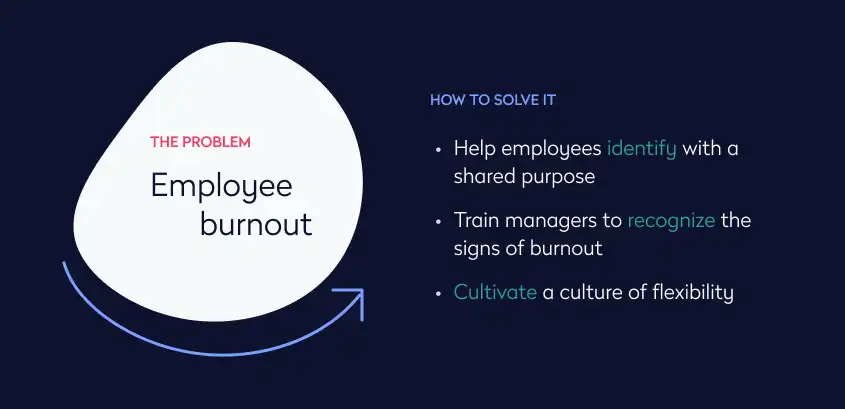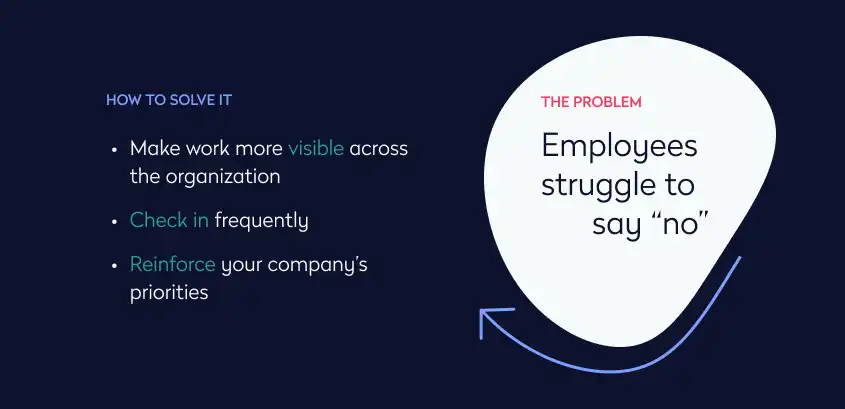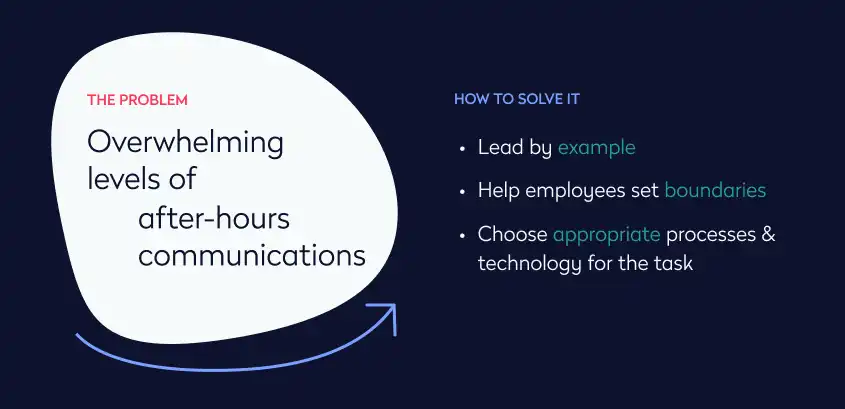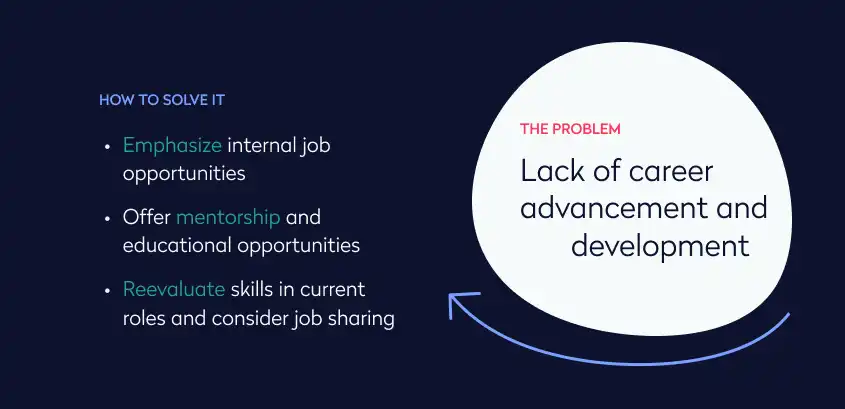Quiet quitting was inevitable. It’s been building behind the scenes for a long time. The problem is far from new, but the term recently hit the mainstream thanks to social media. However, the reasons for quiet quitting today are a bit different from earlier years.
To prevent quiet quitting, companies must first identify the causes behind it. But don’t worry – we’ve done the heavy lifting for you.
Learn the top four motivations behind quiet quitting, along with corresponding combat strategies.
Motivation 1: Employee burnout

According to World Psychiatry, the official journal of the World Psychiatry Association:
“Burnout is a psychological syndrome emerging as a prolonged response to chronic interpersonal stressors on the job. The three key dimensions of this response are an overwhelming exhaustion, feelings of cynicism and detachment from the job, and a sense of ineffectiveness and lack of accomplishment.”
When an employee experiences a lack of clarity or ownership in their job, feeling stuck in their role and unable to advance, with an excessive workload and poor work-life boundaries, they may begin to shut down. Rather than opting into the pace or demands of the job, they opt out in self-protection and become quiet quitters.
Burnout and stress have reached new heights across all professions since the pandemic, according to the American Psychological Association. While this paints a bleak picture for employees’ mental health, it’s also an opportunity for employers who care about their people.
Combat strategies
1. Help employees identify with a shared purpose
It’s not just long hours that contribute to burnout — it’s work that feels meaningless or unfulfilling. When employees aren’t connected to the organization’s broader mission and vision, they can become disengaged. This starts with strong onboarding (especially for fully remote employees) and carries over into one-on-one conversations with managers.
Shared physical spaces can also lead to more connection, but it’s important that workers feel psychologically safe to show up. Employees are more likely to return to the office if the environment fosters compassion, understanding, and true collaboration, said Vik Bangia, CEO of Verum Consulting, on the Workplace Innovator Podcast.
2. Train managers to recognize the signs of burnout
Signs of burnout aren’t always obvious, especially if you don’t see employees as frequently as you did in the office. Employees might mask their feelings or pretend all is well. However, every manager within your organization should be able to identify the signs of burnout, including:
- Changes to or loss of motivation, illustrated by missed deadlines, asking for extensions on projects or failing to produce quality work
- Facial and body cues, such as an overall look of tiredness, seeming distracted, slumped posture or slow speech
- Language that is increasingly cynical or negative
When you spot these, don’t rush to conclusions. Instead, create a culture of trust and care by asking employees how they’re feeling and letting them know your goal is to support them better. Remember to address your own signs of burnout, too. Gallup found only one in three managers are currently engaged at work.
3. Cultivate a culture of flexibility
In the new normal of hybrid work, employees should feel enticed — not obligated — to return to an office that’s worth the commute. A compelling office environment helps employees do a better job than they can at home, Bangia suggested. It’s up to leaders to reestablish the value of working in a place specifically designed for work.
When employees understand why your office exists, it’s easier to encourage them to return on a consistent basis, such as the “3-2-2 workweek” — three days in the office, two days at home, and two days off — to maximize flexibility and creativity.
You still need to accommodate remote workers, because the truth is a quiet quitter might quit if you take away flexibility. Create a new hybrid or remote work policy and be sure to outline expected work hours for all workers. Get our remote work policy template here.
If you don’t already have a long-term lease, consider offering coworking spaces. Look into technology that gives you and your workers maximum flexibility, including:
- Desk booking software that makes it easy for employees to reserve space when they need it so they can divide their time between home and the office
- A user-friendly mobile app that allows employees to find people, reserve rooms, request service, and receive visitors
- A cloud-based, integrated workplace management software that allows workplace leaders to manage space, assets, and maintenance
- Digital room scheduling panels, which make it easy for employees to see which rooms are available and reserve them as they’re walking by
Motivation 2: Employees struggle to say ‘no’

There are many reasons why saying ‘no’ at work is difficult for employees. Fear of disappointing their managers or being perceived as uncooperative are chief among them.
Employees who haven’t become accustomed to setting healthy boundaries might be afraid to say ‘no’ when it matters — such as when there’s a new project with unrealistic deadlines, work that falls far outside of their expertise, or tasks they are tempted to do while sick or on vacation.
Too much ’yes’ can lead to burnout, resentment or a hard ‘no’ from quiet quitters — who begin to reject anything beyond their job description or pay rate.
For some groups, saying ‘no’ isn’t an option unless the work culture supports it. Unfortunately, it’s a hard truth that quiet quitting is a privilege for white-collar employees and those not impacted by inequality at work.
“Unfortunately, in corporate America, minorities are held to a different standard,” said Jha’nee Carter, owner of HR Queen Consulting, in a Los Angeles Times article. “We are looked at differently, there is unconscious bias still, and so we have to go above and beyond in order to be successful.”
A study by McKinsey found that women, especially women of color, are less likely to be promoted to management positions and less likely to land in leadership positions.
Combat strategies
1. Make work more visible across the organization
Project management tools such as Basecamp or Asana help teams stay organized and make it easier to see what everyone is working on. Even shared calendars that are kept up to date can make a big difference.
Condeco, an Eptura company, recently introduced an integration with Microsoft Teams that makes it easier to synchronize hybrid work schedules and help teams know who is in the office and when. Getting employees excited to collaborate in person can amplify creative opportunities.
2. Check in frequently
This is not the same as micromanaging but refers to having dedicated time — such as a daily team huddle or weekly one-on-one meeting — to determine what each person on the team is tackling. This includes what new projects coworkers may have coming up and how each person might need to adjust their priorities accordingly.
Schedule these check-ins at a reasonable, mutually agreed upon time and keep them brief. Let employees do most of the talking. If you discover they’re overworked, find solutions to spread the work equitably or reprioritize projects.
3. Reinforce your company’s priorities
Everyone at the company should understand what problems your company is solving, why it matters and what priorities align most with their responsibilities. It’s easy to get lost in a to-do list when different department managers pursue every possible opportunity (or even personal agendas) and spend time on projects that won’t truly impact your bottom line.
It can be challenging for employees to balance what’s truly urgent versus truly important. But, as LinkedIn founder Reid Hoffman has said, sometimes you have to let fires burn to stay focused on the right ones.
Motivation 3: Overwhelming levels of after-hours communications

Employees have become conditioned to respond immediately to the sound of notifications, whether it’s a text, a Slack message or a Google chat. These tiny moments seem benign in isolation, but overtime work can seep into personal and family time, disrupting life outside the office.
Quiet quitters are drawing the line on the need to be ‘always on’ and reclaiming their personal time. For example, they may uninstall work apps from personal phones and only check messages during business hours.
Creating boundaries around after-hour communication is healthier for all employees — managers and C-suite execs included. As Alison Greene writes in Slate, “If a company’s business model requires its employees to go above and beyond, the problem isn’t the employees; it’s the business model.”
Combat strategies
1. Lead by example
Your work patterns set the tone for your employees’ actions. For example, if your leadership team makes a habit of responding to emails after hours or while on vacation, your employees will feel pressured to do the same.
Set up an autoresponder template that indicates when you’re available to return messages, and use your calendaring system to set visible working hours. Respect your employees’ time by only scheduling meetings, sending emails or texting during agreed-upon working hours. Setting your work boundaries permits employees to establish their own.
2. Help employees set boundaries
It’s important to set boundaries from the start. When hiring and onboarding, be clear about when and where you expect an employee to work. These expectations may need to be adjusted with current workers through feedback surveys or based on individual conversations with direct reports.
You can also avoid quiet quitting by educating workers on available technology. Messaging platforms like Microsoft Teams easily indicate when a person is available, away, or requests not to be disturbed. Encourage employees to block their calendars when attending meetings or unavailable. This creates a culture of non-urgency, leading to lower stress levels.
2. Choose processes and technology that’s appropriate for the task
One major advantage of the hybrid workplace is that it enables asynchronous communication. Employees can respond within their time zone and keep a project moving without everyone needing to be online simultaneously. This is ideal for many types of work, but there are some situations when meeting face-to-face or virtually in real-time is better.
Start with real-time for high-stakes or emotionally-intense topics to introduce new collaborators to one another and provide forums for Q&A. Meeting room booking systems and a workplace app make these get-togethers easy to schedule in real-time. Then, move the project forward with conversations on cloud-based apps such as Google Workspace or instant messaging on MS Teams.
Motivation 4: Lack of career advancement and development

The number one reason why people leave their jobs is a lack of career development and advancement opportunities, according to Guild’s American Worker Survey Report.
Quiet quitting goes hand-in-hand with lacking a clear career pathway and mobility at work. If your company isn’t engaging employees with meaningful growth opportunities, they might quit for real. In fact, 41% of workers have either changed jobs or looked for a new job with a different employer in the past six months.
Purpose-driven work and intrinsic motivation often lack in those who quietly quit. So rather than blaming employees, evaluate what your company could be doing to offer a role that excites them. In other words: Is there a problem with the employees or a problem with the organization?
There’s a reason quiet quitters don’t quit — they often hold on to hope that something will change. If you provide clearer career mobility and upskilling along with market-competitive compensation, you can turn the tide.
Combat strategies
1. Emphasize internal job opportunities
Two-thirds of employees want to move into a new role, and more than half of them hope it’s at their same company, according to Guild. Make it easy for employees to learn how to apply for newly-created roles in your company. Recruiters can collaborate with hiring managers to ensure that candidates from within are adequately considered.
2. Offer mentorship and educational opportunities
Quiet quitters may feel isolated, and upskilling opportunities may be the antidote. Employee Resource Groups (ERG) and mentorships during company hours revitalize and show that you care about your employees’ futures. Many companies now offer higher education as a benefit of employment.
You can also help employees figure out their next step with learning and development yearly stipends for continuing education, conferences or a new degree. For ERGs, consider paying employee leaders for additional time spent outside their regular salaried tasks.
3. Reevaluate skills in current roles and consider job sharing
While fair compensation is crucial, money isn’t the sole motivation for a quiet quitter. Intrinsic motivations and caring about them as individuals are just as valuable. Find out what excites your employees and provide opportunities to add these values and skills to their work. For example, if someone is motivated by helping others, invite them to team-based activities.
For larger roles that have become unmanageable, consider job sharing — where two people split a full-time job, each working part-time. Employees who feel like they’re living up to their potential are less likely to be disengaged.
Identifying and preventing quiet quitting
Quiet quitting doesn’t only affect your bottom line — it affects the health of your entire organization. The new world of work boundaries promotes a stable working environment for all, from the CEO to the intern. When workers feel well-supported and provided with a renewed purpose and opportunities for growth, their mental health and well-being improve, employee retention rises and profits increase.
Combating this problem starts with identifying it, openly discussing it with employees and using technology that promotes flexibility. Give permission for your employees to say ‘no’ to create a culture that’s psychologically safe for all workers.
Set clear policies on after-hours communication to impact work-life balance positively. Remember, you invested in your employees when you hired them; if you continue to offer them advancement and development opportunities, quiet quitters will become more animated about their work and stay longer.
Bonus feature: Employee survey
The following questions will help you determine how engaged your employees are and if you’re at risk of having quiet quitters. We recommend allowing your employees to respond anonymously to guarantee truthful answers. You can send this to your employees through Google Forms, SurveyMonkey or a similar platform.
- Do you think your boss understands what you most need to get your job done?
- Do you talk about your personal life at work or keep it strictly business?
- Are you satisfied with the amount of flexibility you have?
- Is your salary in line with market value?
- Do you have a clear understanding of what is expected of you?
- Do you worry about your job security? If so, how often on average?
- Do you feel connected to your company’s mission or purpose?
- Do you receive regular recognition for your work?
- Do you receive support through professional development?
- How would you rank your work-life balance?
- Do you feel comfortable calling in sick when needed?
- Can you take a reasonable amount of time off?
Following the survey, evaluate the questions where your employees’ rankings fell short and consider corresponding suggestions with your team. This will help you determine whether you have quiet quitters among you and where you should make improvements.

